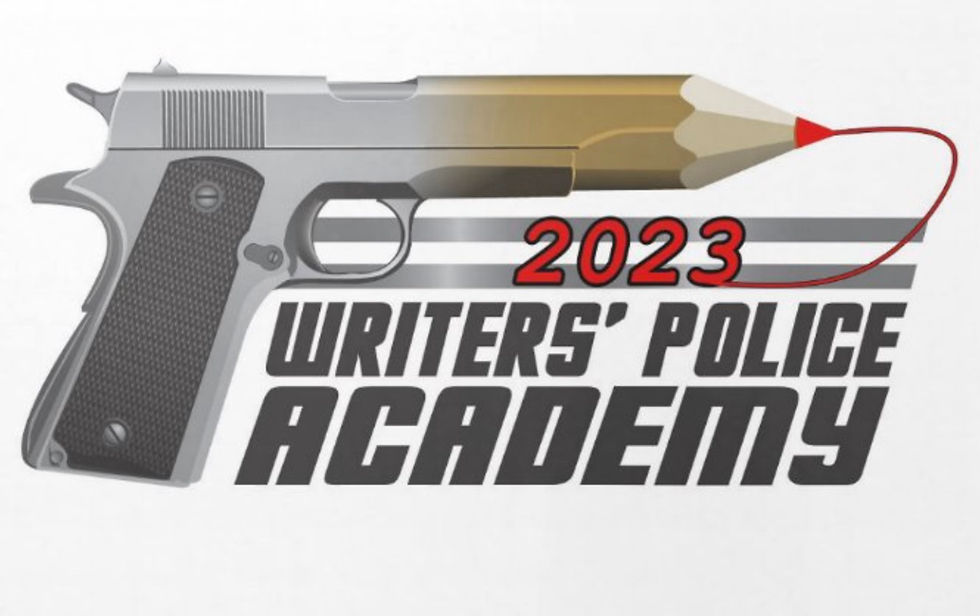
I was on a road trip in the United States during March and April 2023, when we drove down along the Mississippi River from La Crosse, Wisconsin, to Biloxi, Mississippi. It was a birthday trip to catch up with our son, who lives in California. We do this annually and have already been to 48 states of America, driving over 48 000 kilometers (30 000 miles). Our bucket list dream has always been to visit each of the 50 states. Alaska and Hawaii escaped us during the pandemic, but we plan to see these two states soon.
During this March/April trip, I caught up with my author friends from America, as we do at every opportunity. Usually, we have a writer's retreat in a peaceful corner of America, but this time we decided just to have fun in Chicago. After our fun trip, and on my way home, one of them sent me an enticing message saying there was a “Writer's Police Academy conference” in June, hinting that I should either stay (for over two months?) or return to America in June. Usually, the budget does not allow for two trips in a year, let alone in a year where we planned to go to Europe for the Cannes Film Festival. Upon hearing that this “Writer's Police Academy” will not be repeated – it's the last one – and that the Jeffrey Dahmer case, as well as other serial killers, will be discussed, it was too much of a temptation.
My 10-year USA VISA only allows me to be on American soil for 90 days at a time, so I would have to return. A grueling schedule, many long overnight flights, and terrible layovers (cheap fares be like) were my destiny.
The cost of the conference, however, made me think twice. The price was affordable in dollars at $545, but considering the Rand was tanking (R10 000), not so much in Rand. I saw an invitation to apply for the "Tami Hoag Writer's Police Academy Registration Giveaway." I decided it would be my sign – I was meant to go if I won a free entry.
And I did!
On 17 April, Lee Lofland notified me that I had won a free seat. My husband was on board, but the dogs were less thrilled as I broke the promise not to leave them for more than a month a year.
After a brief “rest” in Chicago (my flight had been a thirty-one-hour journey), I was eager to attend the conference. But first, I had to walk the Chicago Art Institute for over 7 kilometers because Van Gogh was in the house.
It was surprisingly cold in Chicago (and raining), and I had every excuse in the book (pun intended) to stop en route at the Pleasant Prairie Premium Outlets in Wisconsin to acquire some warmer gear. (Gear never used – warm weather was ahead.) Road trips are one of my favorite past times, and I had rented a good S.U.V. The road works on the I-41, and I-94 W was quite heavy, but I enjoyed the 3-hour drive to the Green Bay area. Since I had been to Wisconsin before (not Appleton exactly), I knew I would probably not see any Moose, my other obsession other than writing. However, roadkill littered the I-41, and I found it quite upsetting to see unfamiliar deer species and critters accessing the busy highway.
Somehow, the sight of dead humans did not worry me as much as animals – that's what I thought.
DAY 1 – THURSDAY, 8 June 2023
The Hilton Paper Valley Hotel (Appleton, WI) was surprisingly luxurious. My recently renovated room came with a Keurig Coffee Machine. (Meant for writers!) The literary décor appealed to all bookworms, authors, and artists alike.
Our Banquet and breakfasts (at the ungodly hour of 6 am) were set to be at the Hotel. The early breakfast was more like a 'noon snack' as I still suffered from jetlag caused by the 7-hour time difference between Johannesburg and Chicago.
We would also attend classes and demonstrations at the Fox Cities Exhibition Center, the N.W.T.C. (Northeast WI Technical College), the Public Safety Academy (Technical College), and a lecture hall at the college. The arrangements were relatively easy to understand (like "get on a bus, don't be late, and we'll take you there"), even for a South African.
We registered at the Exhibition Hall, where everyone was excited to see which classes they had been allocated to (and who with). We were given a list of classes to choose from, and everyone would not get the opportunity to attend all the available classes. I was lucky to be allocated to most of the choices I had listed as my preferences, albeit often without my "comfort zone" friends. (It can be challenging for us foreigners to bend our ears around the different American accents and adjust our accents and frame of references/word use to the American. Sometimes part of a conversation or presentation can be lost in translation). Admittedly I was a little self-conscious about my accent and intimidated by the writers who already seemed to possess a wealth of knowledge about U.S.A. police procedures, crime scene investigations, the various serial killers and the particular cases discussed, etc. Some were overzealous in "stating" their own research, framed as questions, and wasted precious time during classes. (Mary had to nudge me to "behave" when I started "staring daggers," but I had come to learn from the experts, and every costly minute counted for me). Possibly, being a toastmaster makes it difficult for me when there are no "ground rules" given before a speaker presents – maybe it's not an American thing?
South African police procedures are probably quite different. Still, I was wholly underqualified and much too negative (as a victim of repeated crime) about our law enforcement agencies to answer any questions the Americans had. However, since my trilogy is based in America (specifically Cape Cod, MA, and Phoenix, AZ, this conference was much more relevant than the procedures in my own country.
Touch a Truck and Ask the Experts
I underestimated this exhibition.
The exhibition center was enormous, with several public safety vehicles and different units (vehicles and knowledgeable personnel) to explore. I met with the Fox Crossing Fire Department, Appleton Police, the Operational K9 Medical Team of Wisconsin (with two very loveable dogs, Greta and Stig), a hearse and staff from Larry's Livery, Ambulance, Crime Prevention units, and more.
Everyone was willing to discuss their jobs and gave us in-depth insight and ideas. I had a long talk with the two men from Larry's and instantly learned things I could use in my book, such as the "Date of Death" vs. the "Time of Death" and how bodies are collected and identified with numbers and tags in America. Some of my questions freaked them out (although they kept a straight face), like, "Do you scrape the brain matter together and place it with the body?"
After attending an impromptu drone demonstration, I had severe drone envy. My small drone is laughable compared to the unit that LT Vander Wielen of the Appleton Police demonstrated. Seeing this big drone almost disappear against the blue sky was awe-inspiring, but the zooming capabilities from such a height were even better. (I could see the images on my cell phone from up there, so heads up!) This drone can stay in the air for 45 minutes, remain stable in 60 MP/h winds and fly as high as 400 feet. It allows you to do a “hot swap” (of the batteries) when searching for a perp, even while using advanced infrared cameras. Facial recognition is not currently built-in, but that was an excellent question.
I could have gained much more information from this session had I planned to spend more time there, but the information I did collect was invaluable. (I also neglected to register for a certificate from the college. Boo.)
Orientation and A story in Photos by Mike De Sisti
The conference host, Lee Lofland, opened the conference and welcomed all the attendees and presenters. He sternly warned that anyone caught recording any sessions, whether photographically or with audio, would be escorted by him off the site. The agreement was to protect the innocent (including victims' families) and active undercover personnel involved in the conference. Police officers, who infiltrate criminal networks to pose as offenders, are vigilant not to be exposed by the innocent photos of bystanders and, in this case, a class of eager writers. It can be life-threatening and mean the loss of years of work on an ongoing sting.
That evening we attended a presentation by Sentinel photojournalist Mike De Sisti who covered much of his photos from the Waukesha Christmas Parade Attack (where six people lost their lives on 21 November 2021) and showed us some of his photographs taken in the court as the sole pool photographer. To this day, Darrell Brooks, a man who decided to defend himself and proceeded to 'piss off' the judge more than anything else, has been unable to say why he did it other than that he had been arguing with his girlfriend minutes before. It was interesting to hear how Mike’s Day can turn “in an instant” and how family commitments sometimes come second when there is an opportunity to capture a moment in history. His expressive photos paint a thousand words – I appreciate how photojournalists do much more than just record the drama.
I met a writer from the UK and one from New Zealand. Of course, I had lots of fun with my regular group of friends.
DAY 2 – FRIDAY
Surprise Live simulation by S.W.A.T.
After an early (06:00!) breakfast, we transferred by School bus to the T.W.T.C. Public Safety Training complex, where upon arrival, we were treated to a live simulation by the Green Bay Police S.W.A.T. team.
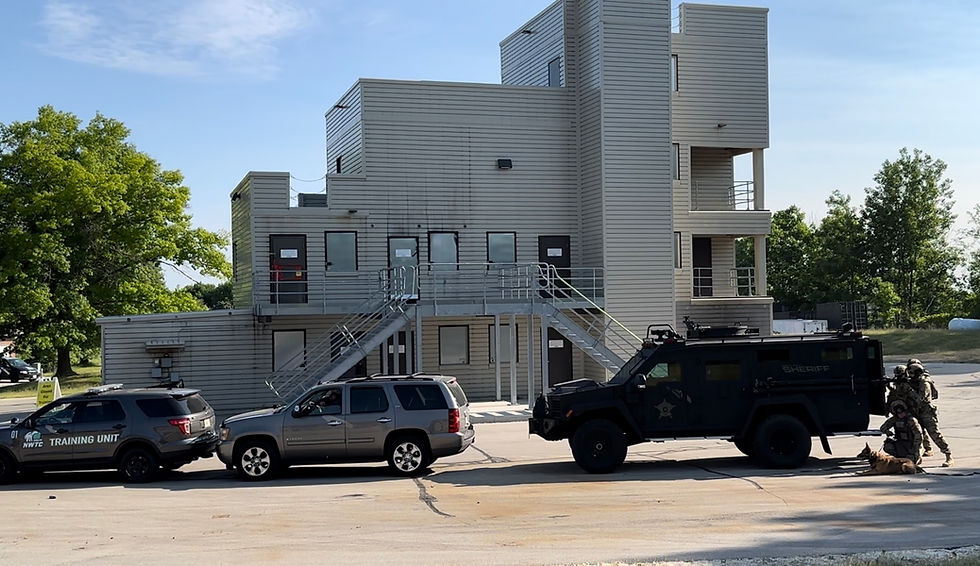
I almost dropped my phone (we were encouraged to take footage) when the "stun/flashbang grenade" was introduced into the scene. The potassium perchlorate and aluminum powder pack a serious light and sound (around 170-180 decibels) effect. It yields a significant amount of smoke to assist in close-quarters combat and door breaches. It was interesting to learn that the "cherry bomb projectiles" (bullets) used during the mock attack did not harm the K9 at the scene. The non-oil PAVA (a plant with one of the hottest capsaicinoids found in pepper plants) is a highly effective and debilitating “weapon,” causing short-term blindness, breathing difficulties, and a burning sensation on the skin. Luckily, we were standing more than the recommended 60 feet away. (I will be looking into acquiring this at home for my security staff.) I had fun pretending I was part of S.W.A.T.
First Session: "A Coroner's Life" – Curtis Green
"A Coroner is the protector of the living through the investigation of death."
We first learned the difference between a "Coroner" and a "Medical Examiner." This information is pertinent to my trilogy as I have a Medical Examiner as a solid second character. (A Coroner is elected and may or may not have a lot of training, whereas a Medical Examiner has lots of degrees and experience.)
Curtis is in his last term as the elected Coroner for Manitowoc County, Wisconsin. Still, he has vast knowledge and experience in Police science, a degree in Paramedics, and various certifications in Death investigations. He divulged that his most significant training came after the 9-11 attacks when he was assigned to the New York M.E’s office.
One thing I never appreciated was how much Admin and liaison must be done by this office - with the decedent's loved ones, the pathologists, law enforcement, funeral homes, registers of dead, or programs like "NamUs." (I was thrilled when he mentioned the "National Missing and Unidentified Persons System" that features in my first book, LAPSE).
Curtis told us that curiosity, intelligence, and a strong stomach made for the best Medical Examiner and reminded us that someone has died doing everything you've ever done – death happens anywhere. He's seen it all, or almost all. He has low regard for social media, their disregard, and disrespect for the privacy and feelings of the families of decedents.
We learned that most Coroners deal with about 88% medical deaths (natural) and only 12% criminal or abnormal deaths and that autopsies are sometimes tricky to do when families object, primarily where children are concerned.
This class was very relevant to my current works, especially how the time of death is determined, crime scene preservation, and whether a body was moved or manipulated after death. I will use the "Tache Noire Eye," which is an ocular sign that the eyes were exposed to air after the time of death and occurs transversely in a reddish-brown discoloration across the eye's sclera.
Ninety minutes was not nearly enough time to spend (we did not complete all his slides and were not allowed to take photos of them, nor were they supplied on paper, which was sad) with this man. I shall contact him at the email address he provided so happily. I wonder if he knows how supplying his contact details was like chum for a shark to any writer.
Second Session: "Crime Scene Investigation" – Holly Maas
Finally, I met the kind of people that inspires shows like C.S.I. and Holly Maas, and Dan even looked like Grissom and Sara. (Although, in this case, they are not a couple but have worked together for many years.) I was riveted by everything from the get-go.
Holly very quickly set the record straight as to the difference between "Crime lab forensics" and "Crime scene forensics" and how their jobs, knowledge, and responsibilities were entirely different. Holly is a Crime Scene Analyst and Investigator specializing in collecting evidence, and the procedures involved, from lifting fingerprints to collecting D.N.A. and interpreting blood spatter.
Rushing through a scene can lead to mistakes. Holly emphasized that this does not make them very likable (with many departments that are chomping at the bit to put a case in bed) but that preserving the scene and collecting evidence was more important than a popularity test. Although the body is not under the jurisdiction of the Crime Scene Investigators, it remains their duty to ensure everything around the body is appropriately assessed, documented, and investigated. People's lives depend on it.
Holly told us how hot it is in their $15 Tyvek suits (a "Moonsuit" was donned by a lucky writer), how they used a new pair of gloves to handle each item, and how vital a crime scene log is. Warrants to enter a location for investigation, list and describes the specific items allowed to be removed, specifying the date and time for access. If someone removed an item not listed or did so later, it could cause untold misery during a court case. This certainly makes good fodder for a crime story.
Holly's presentation about collecting evidence, which includes "negative evidence" (the lack of evidence), was very informative. I now know that wearing just one pair of Latex gloves may not prevent fingerprints from being left behind - I may use this in one of my books.
Unfortunately, time was a real issue with this presentation, and we did not complete all the slides offered, nor were we allowed to photograph or receive any copies of them.
I could spend days with Holly and not have enough time. Since Holly is actively employed, I doubt she has time to field my many questions.
Third Session: “TI Training” – Jason Feucht
This session opened my eyes to the problematic scenarios Police officers often encounter. When is deadly force justified, and when not? Officers have seconds to perceive and identify threats when confronted by seemingly innocent or potentially dangerous individuals.
We were placed in front of a screen with a weapon that interacted with the screen and characters. We were not given any idea as to what we could expect other than we would have seconds (in real life, officers have less than 0.4 seconds to react) to decide if we shoot or talk a suspect down.
Some of the authors shot immediately, others got shot immediately, and Jason, who had served for many years undercover (but has now cleaned up with short hair, he says), gave valuable feedback. I was placed in a scenario with an irate suspect in a church who suddenly drew a sword. You don't know what she's producing from her pocket and have only milliseconds to identify the weapon and perceive the intent. With just seconds to react, I stepped back, believing that taking cover was an option because if it was a gun, I doubted that she was a 'crack shot' (but assumptions like this get you killed), and instructed her to drop the weapon. Luckily, I did not shoot the person who merely suffered a mental breakdown. (Anyway, she came to a gunfight with a knife.) My feedback was positive, although my accent and word usage were a little different – something to remember for my books set in the U.S.A.
The session was a trigger for someone like me who has twice stared down the barrel of a gun. In real life (where I’m not instructed to carefully consider the use of deadly force), I would probably ask questions after shooting.
After this session, I have an increased respect for the officers that face these awful situations daily and the subsequent scrutiny they are under from the public afterward. It must feel like a kick in the teeth, I’m sure. (“Everybody is into Monday morning quarterbacking.”) I believe that all citizens should attend a course like this and realize how dangerous it is to draw (even a stapler in a mock attack) on a Police officer who faces danger daily, where nothing is what it seems, and every situation and perp is different. How can you possibly know what a stranger’s intent is? Until you feel this adrenaline rush and fear, you cannot fully comprehend how this could potentially cause mental issues over the years. (Facing a gun only twice in my lifetime has caused generalized anxiety and an immense fear while driving at night). Police officers are expected to preserve life, be respectful, and care about the victim and the criminal. I can’t imagine caring for any criminal after a while, especially since I’m a human with a family too. I salute you.
An Evening with Steven Spingola: The Spingola Files
It was finally time to meet "The Sleuth with the proof," (Steven Spingola worked for 15 years as a Lieutenant Detective for the Milwaukee Police Department. He graduated from the FBI National Academy in 2001), who was a significant consideration for me to attend the conference. It was both a treat and a shocker.
Snippets of Steven's conversations with Jeffrey Dahmer, (Dahmer was a prolific serial killer who killed, tortured, raped, and dismantled seventeen young, mostly gay men.), who he “casually” calls "Jeff," were shared with us. Steven walked us through Jeffrey Dahmer's crimes (and his apartment) with some gruesome photos and recollected his conversations with Dahmer, who he said was "truthful" and eager to answer any questions when interrogated. Several photographs collected by the serial killer (of his naked, mutilated deceased victims in horrendous poses) were displayed on a large screen. I did not think I could react to these scenes as I did; it was decidedly worse than the roadkill that had upset me on the way there. Like any writer, I hung onto each word, never taking my eyes off any of the graphic images. Go figure.
It is interesting how Serial Killers are actually "very clever" in manipulating the truth and are "the biggest bullshitters" known to man. One witness told the Police there was no way Jeff could be guilty of anything while back in his fridge; the case was solving itself, with several severed heads and body parts ready for Jeff's next meal. More disturbing was how he had showered and gone shopping with some of the skulls to keep his victims close – it was some kind of “romance” for him.
After this talk, I had to unwind with some photos of kittens and puppies and understood one of my favorite writers, Karin Slaughter's (who, incidentally, had also attended this conference in previous years) preoccupation with cats! Karin Slaughter’s understanding and knowledge of the Police and procedures has always impressed me, and I was thrilled to learn that she also valued these conferences. This "bedtime story" did not make for a good night's rest, but the shocking reality is that Jeff Dahmer was not the only madman honing his "craft" in that era.
Steven Spingola did not disappoint, and I was eager to get a photo with him. I looked like the cat that got the milk and I was blushing.
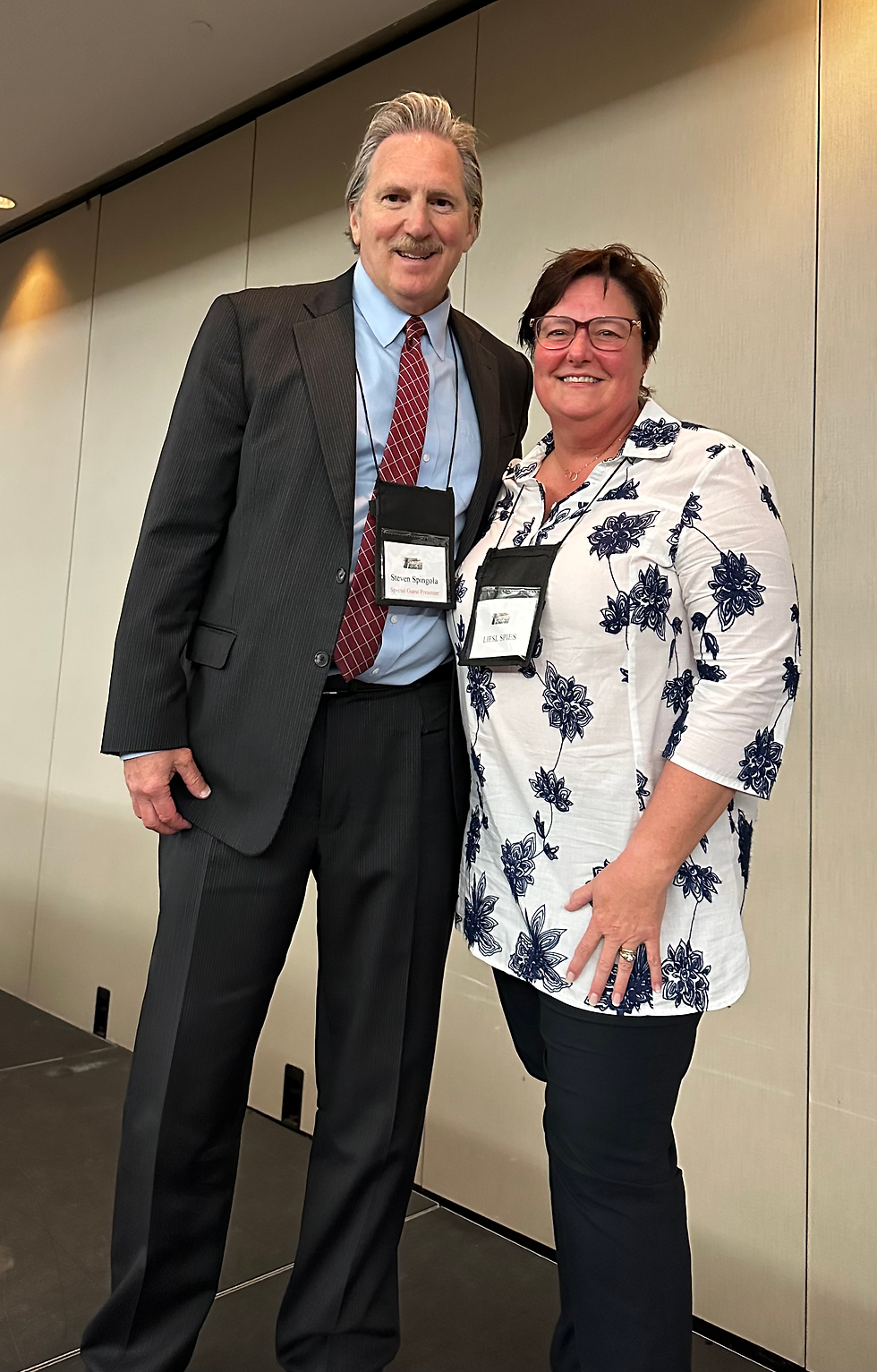
I will be downloading all the “Cold Justice” episodes (Oxygen channel True Crime program) for my flight home as if I wasn't freaked out enough. Of course, no photos of any of the scenes were allowed, but after some Google searches, I found many of them. Humans will be depraved no matter how much we try to tell ourselves differently. Society will give birth to these sick individuals, and whether it's “nature” or “nurture,” serial killing will continue, and we will continue watching documentaries about them on Netflix for entertainment. The work and insight of people like Steven are necessary if we hope to unspool these complex minds.
DAY 3 – SATURDAY
Session 1: Homicide 101 – Michael A. Black
"Our day begins when yours end."
As an avid follower of shows like C.S.I., I was waiting in anticipation for this veteran police officer to tell us where these shows get it wrong. Michael has written 48 books and is a retired police officer from the Chicago area. He worked in S.W.A.T. operations and was awarded the Cook County Medal of Merit in 2010, and this interview is very insightful for writers.
It was interesting to learn that a homicide case will remain open and only be closed once an arrest is made. Different states in America may view First degree (Intentional and premeditated murder), Second degree (Murder without premeditation), and Voluntary manslaughter (Unintentional murder while committing another crime) differently. For example, Illinois places a lot of emphasis on aggravating factors. This is an important consideration for my books.
There are two kinds of crime scene tapes, the yellow we see on T.V. (which is at the outer perimeter of the scene) and the red surrounding the immediate area of the body.
We discussed the importance of the first 48 hours at a scene of investigation and the different kinds of evidence, being “Circumstantial,” “Witness,” and “Direct evidence” (physical evidence). It was an eye-opener to learn that officers cannot leave a scene until they have finished with processing, not even for a lunch break, unless they want to return with a warrant.
We were shown different kinds of bags specific to the type of evidence, such as plastic vs paper bags. Michael explained body temperature, rigor mortis, lividity, and the seven steps of a crime scene protocol. The importance of timing when apprehending a suspect was discussed, and how this also differs from state to state, how a judge won't give a warrant if you don't have enough evidence to hold a suspect, sometimes allowing a suspect to dispose of critical evidence at his home or on his cell phone, all very relevant to my books. T.V. shows often get it wrong when the "Miranda" is read to a suspect. It is read after a suspect is arrested, not when they are taken in for questioning.
Michael touched on how bones can split when bodies burn, and my interest was piqued here as I have a charred body in my book LAPSE. I know Michael will be an invaluable source when I fact-check!
Michael, an author of 45 books, gave us an excellent base by sharing his vast knowledge. Luckily, we were allowed to take photos of some of his slides (none of the actual homicide scenes), but a “handout” would have been better because taking notes and following him was tough within a minimal time frame. This class could be at least double the time allocated.
Session 2: Death by Powder and Pills – Nick Place
I was lukewarm about attending this class (I tend to avoid any shows or books about drugs and the drug trade), but it blew me away.
Officer Nick Place is a drug recognition expert and instructor (owner of a company that trains on drug trends, identifying drug impairment and novel T.H.C. and opiates) and gave us a scary glimpse of the drugs in the United States. His humorous take on the "drug operation" of "Dave and his brother Dave" had us in stitches.
He told us how he was training his dog to imprint on specific drugs, and I was happy to learn that his dog gets a treat even if she doesn't find drugs because you should reward the "job well done" and not just the "positive find." He explained how dogs “work the cone” when sniffing for drugs and how dogs "alert" to a find, giving the Police the right to search.
I found the effects of different drugs on the human pupil most interesting. This is not only helpful information for the description of drugged individuals in our books but also in our daily life.
The recent Fentanyl crisis was discussed. Fentanyl is 50 times more potent than heroin, and the scary statistics of the percentages of pills on the market before Covid (2/10 contained lethal O.D. levels) that delivered an overdose compared to the drugs now in 2023 (6/10 compounds consist of lethal O.D. levels) were mind-blowing. The use of Narcan was explained, and it can render this life-saving solution almost useless when a substance like Benadryl is mixed into these drugs. It left us shaking our heads because Nick said that the "best high is the one just before you die."
We made our own “pills” with his encapsulating unit, complete with dies, creating different markings on our pills. Nick said that Amazon was a prominent supplier of most ingredients and tools to produce "pills" and dangerous compounds. Downright incomprehensible unless you use it, I guess. Making your own "smarties" is a big business!
This class opened many possibilities and thought-provoking ideas for my books, and I am grateful that I was in it. I loved that Nick's wife invited us to send her any books to read as a Beta reader – she will soon be inundated with material. Nick promised to send us a copy of his slides, and I'm eagerly awaiting them.
Session 3: Cold Cases – Bruce Robert Coffin
Listening to someone with 28 years of service in Law Enforcement is a privilege, especially since he is also a writer.
Bruce explained how cases go cold, the reasons, how they may be revived, and how some will never be closed until solved.
We learned that witness testimonials are one of the least reliable things you could have in a case, how every single piece of evidence must be handed over to both the prosecutor and the defense and how trials fail because of this omittance. (I know this from watching shows like “The Lincoln Lawyer”) D.N.A. and the technology around this are the primary reasons cold cases are reopened nowadays.
Cold cases come with challenges, such as that elapsed time "degrades" evidence, witnesses "forget," and people move on. Law enforcement involved in cases may get re-assigned, retire, or even die, taking a wealth of information with them. Sometimes budget restraints cause cases to go cold as D.N.A. tests are expensive and time-consuming.
Bruce gave us some insight into the life of a detective and how difficult it is not to take the horrific things they see and hear home with them and effectively cause them to lead a double life. "The dishwasher is broken at home, and it is as important as the victim lying in the alley waiting for you to find the killer." You must balance everything in your mind.
I had a problem finding a believable reason for my F.B.I. Agent character to “want” to pair up with my hacker, and Bruce gave me a brilliant idea and solution without knowing.
No photos were allowed, though, especially of the crime scenes, and there were no "handouts" either, so I might contact Bruce to verify a few things. We needed at least another hour with this fascinating man.
Dr. Katherine Ramsland: The Candy Man's Handyman…and Killer
I had no idea who Katherine Ramsland was, but within an instant of her speaking, I realized this was someone who was living the life I was meant to live. Being the author of 70 “very relevant” books and a professor of forensic psychology (DeSales University) made her the most important speaker for me.
Dr. Ramsland allowed us to take photos of her slides but, of course, not of the horrendous crime scenes and D.B.'s. Her special connection with the B.T.K. killer and in-depth knowledge of the minds of serial killers delivered a wealth of information to us as writers, especially for those who are cooking up a serial killer like me. She hinted that she had spoken to the B.T.K killer the night before, and I wondered how it must feel to be on his radar. (Pun intended – Dennis Rader is his real name.)
The "script theory" of how a killer scripts a crime, how he organizes himself, his decision-making, and a sequence of logical steps is something I'm going to research further.
The ability of some serial killers to "cube" or "compartmentalize" their lives, therefore effectively being able to disassociate from their crimes, was fascinating and had already shown up in my work. What does it say of you if you already do this? Hmmm. Crime Writers are all serial killers, just on paper.
Dr. Ramsland told us more about Dean Corll, (The "Candy Man" or the "Pied Piper"), an American Serial Killer and sex offender who abducted, raped, and tortured at least twenty-eight teenage boys. He had abducted and trained two teenagers, David Brooks and Elmar Wayne Henley. He was killed by his accomplice, Henley. The "temporary psychopathy" condition of some youthful co-conspirators was thought-provoking, especially in how they could commit the cruelest of crimes and feel no remorse "at the moment of the crime" but years later cannot believe that they had committed it. Practical and very useful, especially when creating those anti-heroes I like so much.
I couldn't wait to purchase Dr. Ramsland's book and devoured it on the flight home. My serial killer now has a rich background, and I have a much better understanding of his mind thanks to this presentation. (But I refuse to hurt any animals, even in a book!)
I regret not getting a photo with Dr. Ramsland, but I hope our paths might cross again - she signed my copy. My "stalker-self" has since found her on Audible and various other platforms – I'm not a weirdo at all.
Keynote: Hank Phillipi Ryan
Besides her beautiful name, Hank is a stylish bestselling author from the U.S.A. She has written 14 psychological thrillers – so her work is right up my alley. She has an interesting T.E.D. talk about why she reads the last page first; sometimes considered a great offense, but secretly, I do this too.
Hank's keynote speech was inspiring, uplifting, and often downright funny. It gave us a good insight into her riveting life and career. (Covering the Boston bombing must have been heart-wrenching.) She had everyone hanging onto her every word, and in the end, we were all ready to go out and "write the song”!
DAY 4 – SUNDAY
The last day was reserved for some "Q & A" time with all the writers to discuss their WIP (works in process) questions. I had a flight to catch in Chicago (you can't choose dates when you buy the cheap seats), and besides, I suffer from an irrational fear that once I discuss my WIP too much, it may evolve into infinity, or the ideas may be used by a more accomplished writer first!
After a brief breakfast with my author friends, I was back on the road only to learn a little later that my flight had been delayed by three hours—big eye roll.
Overall, I absolutely could justify the time and cost of this conference. It was well organized by Lee Lofland and his wife, Dr. Denene Lofland, publishers at New Arc Books. Lee, a "born raconteur," is a veteran police investigator (and achieved the highly-prized gold shield of “detective”) and writer of a resourceful blog, the Graveyard Shift – and yes, he signed my copy of his guide for writers, "Police Procedure, and Investigation." I have no excuse for mistakes when I portray how the police work, but I'm sure I'll be networking with Lee and other presenters to ensure this does not happen in any of my books.
The Writer's Police Academy has at its kernel the great opportunity to "network," which is an unparalleled opportunity for writers in the “killing” genre. Where else can you pretend to step into the shoes of a police officer, a crime scene investigator, a coroner, and a writer all in one conference? As Lee said, this conference is impossible without generous sponsors, and I would like to thank Tami Hoag, whose book, "The Boy," I am currently reading, for the opportunity that fell into my lap. I will not forget to pay it forward when I sell my trilogy, which will be so much richer after this experience.
Writers who have attended this conference are, amongst others, Lisa Gardner, Kathy Reichs, Karin Slaughter, Tami Hoag, and Lee Child, (Yes, Jack Reacher came to this conference!) and, of course, now Liesl Spies too!
I hope that more time will be allocated to classes in 2024, that there will be more hands-on opportunities for every attendee, and that there might be a class by a writer to explain how to weave all this information seamlessly into our work. (Even if there are fewer topics). I realize how frustrating it must be to decide where to draw the line with the vast content possibilities.
I will do my best to attend the “2024 Killer Con” (6-9 June 2024) as, based on the 2023 Writer's Police Academy conference, it can only be another invaluable experience. Of course, it will be a brilliant excuse to catch up with my scintillating America Authors too.
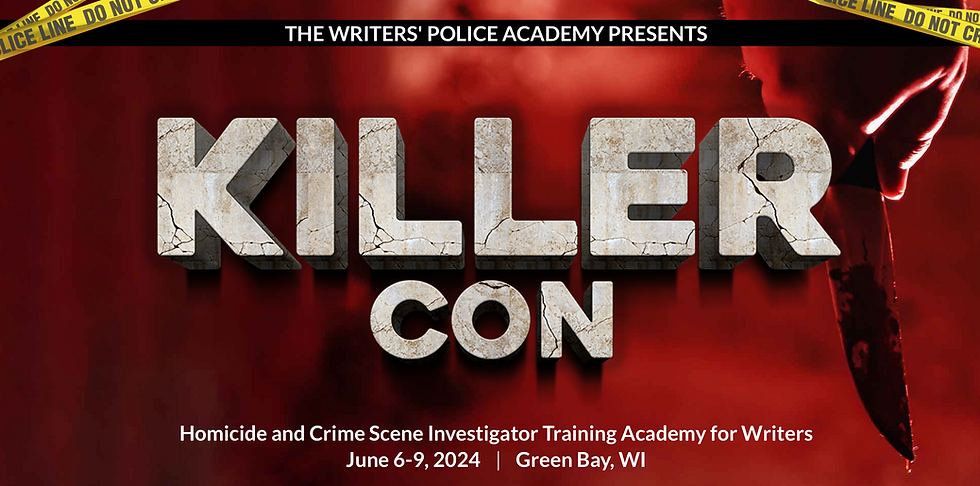

















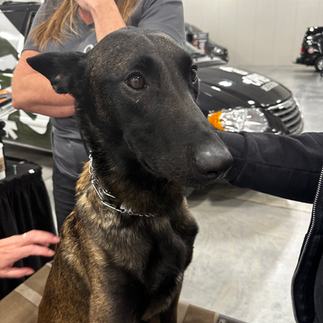











































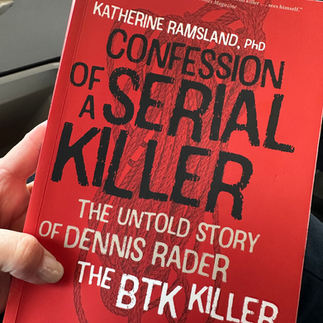







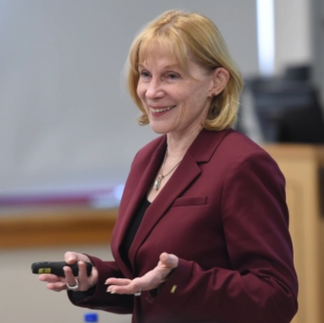



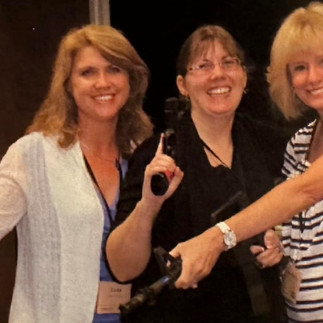



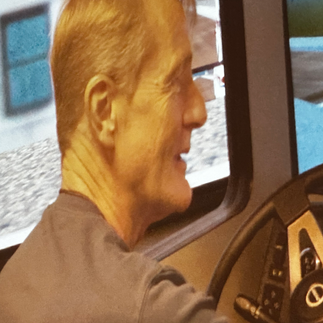






Comments